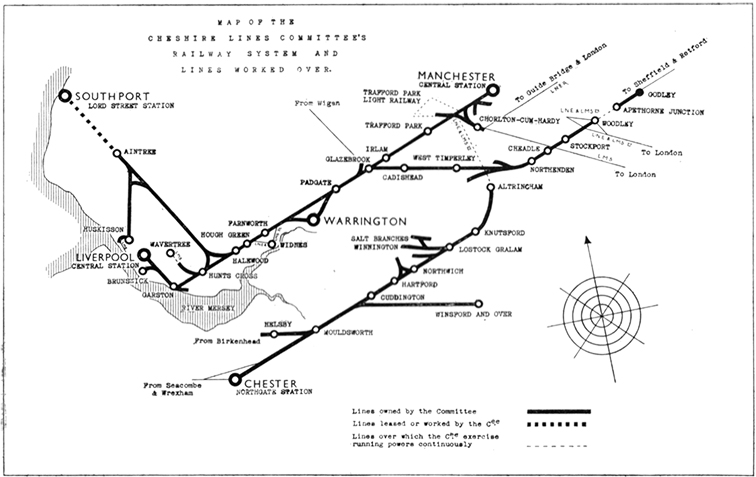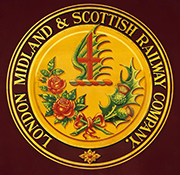

This site uses non-intrusive cookies to enable us to provide a better user experience for our visitors. No personal information is collected or stored from these cookies. The Society's policy is fully explained here. By continuing to use this site you are agreeing to the use of cookies.
[as reported in the March 1937 edition of the “in-house” LMS Magazine.]

A RAILWAY operating its own train services over nearly 150 miles of line, and possessing more than 300 passenger coaches-but not a single locomotive!
This is the apparent paradox of the Cheshire Lines, the busiest and most important commercially, if not the largest in point of view of mileage, of the three principal joint railways in which the L M S Railway is a partner. The paradox is simply explained, however, in that, with the exception of through L M S trains to and from the Joint Committee's system, motive power for Cheshire Lines trains is provided by the London & North Eastern Railway.
As successor to the Great Northern and Great Central Railways (the latter formerly the Manchester, Sheffield & Lincolnshire), the L& NE owns a two-thirds share in the Cheshire Lines, the L M S Company's one-third interest having originally been that of the Midland Railway. Each of these Companies owned, in pre-grouping days, a one-third interest in the Cheshire Lines, which otherwise had no individual shareholders.
Apart from the fact that it has no locomotives of its own, another curious feature of the Cheshire Lines is that, despite its title, the greater part of the system, together with its two principal termini-Manchester (Central) and Liverpool (Central)-are actually located in Lancashire, and it is upon the commerce and industry of the county Palatine that the system principally depends for its traffic.
In origin, the Cheshire Lines were entirely competitive, representing the outcome of the efforts of the Great Northern, the Manchester, Sheffield & Lincolnshire and the Midland Companies to tap the vast traffic resources of the Port of Liverpool and of Merseyside generally. So far as the Great Northern Company was concerned, its participation was only made possible by the alliance for traffic working which it had formed with the M S & L Company in 1857, for the Great Northern was completely isolated from the Cheshire Lines area. Historically, the position is a little confusing, but it may be summed up in this way: that the Great Northern and Midland Companies having come to arrangements with the M S & L Company in order to obtain access to Manchester, agreed with the last-named Company that further expansion by any of the three companies from Manchester towards Liverpool should either be on a joint basis, or on that of unrestricted running powers. It is also necessary to remember that the Midland Railway's first means of access from the south into Manchester was obtained in conjunction with the M S & L Company from New Mills, through Ashburys into London Road station, this station being used by Midland trains from February, 1867, until August 2, 1880, when they were diverted via Stockport and the Manchester South District Railway into the Manchester (Central) station of the Cheshire Lines. (The present direct route via Hazel Grove was brought into use in 1902.)
The original Cheshire Lines undertaking comprised five separate and fairly short local lines in the Manchester and Liverpool areas, with an aggregate length of 51 miles, the earliest (opened 1862) being that from Altrincham to Knutsford. By the Cheshire Lines (Transfer) Act of 1865, these lines were vested in the Great Northern, Manchester, Sheffield & Lincolnshire and Midland Companies jointly, under the management of the Cheshire Lines Committee. By a further Act of 1866, powers already granted to the M S & L Company for the construction of railways from Corn brook to Garston, and from Timperley to Glazebrook, were transferred to, and vested in, the three Companies jointly. By the Cheshire Lines Act of 1867, the Cheshire Lines Committee was incorporated by that name, with perpetual succession and a common seal.
The main line was opened throughout from Manchester to Liverpool on July 9, 1877, the terminus at Manchester (Central) being a temporary one pending the completion of the present Central Station on July 1, 1880. Midland Railway trains had begun to run through to Liverpool in 1875. Manchester Central station has nine platforms and thirteen "roads", and covers an area of ten acres ; the station, which accommodates the traffic of the former Midland and Great Central Companies as well as of the Joint Line (there are no longer any services at Manchester Central appertaining to the former Great Northern), has recently been re-signalled with all-electric equipment.
The main line thus completed was the third of the principal routes between Liverpool and Manchester, its length of 34 miles comparing with 31½ by the former L & NWR and 36} by the Lancashire and Yorkshire. This is naturally the principal route of the Cheshire Lines, and became known as "The Punctual Route", with hourly expresses between Liverpool and Manchester, and vice versa, which, in the case of trains avoiding Warrington via the Straight Line, made the journey (33¾ miles) in 40 minutes. The present standard time is 45 minutes, including stops at Warrington and Farnworth, or 43 minutes when stopping only at Warrington ; until comparatively recent years the Great Central "single-wheelers" were used on this service, but these have now been displaced by four-coupled engines of Great Central and Great Northern origin. Apart from the Liverpool-Manchester trains, the route is used by L N E through trains to and from the Great Central Section, and by through trains to and from the Midland Division of the L M S system. The latter diverge from, or join, the Cheshire Lines, at Cheadle junction, whilst there are also connections farther west at Northenden Junction, and at Skelton junction, between the Cheshire Lines and the L M S Western Division lines.

A pre-grouping view, showing a Liverpool-Manchester C L C express, hauled by a G C R 4-2-2 engine
Although undulating in character, with frequent stretches averaging I in 185, the main line is generally suitable for fast running. The easterly section of the main line from Stockport to Godley is, however, severely graded, and it is here that the steepest main-line gradient (I in 61 for 1¼ miles rising from near Bredbury Junction to Woodley) occurs. The steepest incline on the whole of the Cheshire Lines is 1 in 53 on the Winnington branch. but this is not used by passenger trains. The last two miles of the main line at the Liverpool end are almost entirely in tunnel, that at Dingle (¾ mile) being the longest on the system. At Hunt's Cross, 7 miles east of Liverpool, an important branch goes off parallel with the coast to Southport (Lord Street) ; from Aintree to Southport this is the Southport & Cheshire Lines Extension Railway, opened in 1884, and worked by the Cheshire Lines under agreement. Aintree is one of the stations serving the famous racecourse and, on Grand National day especially, locomotives from almost all parts of the L M Sand L N E systems are to be seen there. Another C L C line connects with the Southport branch at Fazackerley Junction, and runs through the north-west of Liverpool to give access to the Huskisson and other docks below the pier-head ; a large depot at Brunswick, on a short branch from the main line, serves the upper section of the Liverpool docks. There are also two Cheshire Lines goods depots on the other side of the Mersey, in Birkenhead, reached over the L M S and G W joint Line from Helsby. The Cheshire Lines also has extensive connections with the Manchester Ship Canal Lines.
South of the Mersey, the principal line owned by the Committee is that from Manchester to Chester, 38½ miles long, and running roughly parallel with the Liverpool line. This actually commences at Altrincham, 7¾ miles from Manchester, Cheshire Lines trains gaining access to it by means of the Manchester, South junction & Altrincham line ; it includes the oldest section (Altrincham-Knutsford), together with the Helsby, Winsford & Over, Winnington and Northwich "Salt Lines" branches. The line was completed in 1875 through to Chester, where connection is made with the L N E (G C) lines from Connahs Quay. Chester (Northgate) station is also used by L N E passenger services to and from Wrexham and Seacombe.
Thus the total route mileage of the Cheshire Lines system amounts to 143 miles 49 chains (including 14 miles 3 chains leased of the Southport & Cheshire Lines Extension Railway), equivalent to 446 miles 79 chains when reduced to single track (including sidings) ; the whole of the main lines are double track, while slightly more than 7 miles of the main lines are four-track.
While both the owning companies work trains of their coaching stock, hauled by their locomotives, over the Cheshire Lines, the Committee provides its own coaching stock for local services. There are in all 346 coaching vehicles, 302 of which are passenger-carrying, while there are also four steam rail cars (one class only). The Committee owns no freight-carrying vehicles, but possesses 54 goods brake vans and 158 service vehicles. (The figures are those applicable to the year 1935.)
In 1935 the Cheshire Lines conveyed well over 11,000,000 passengers (including season-ticket holders), over a million tons of merchandise, etc., including coal, and over 5,000 head of livestock. Iron and steel traffics of various kinds, indicating the industrial importance of the area served, form by far the largest single item of freight traffic.
Site contents Copyright © LMS Society, 2026

January 1st, 2026
Site contents Copyright © LMS Society, 2026